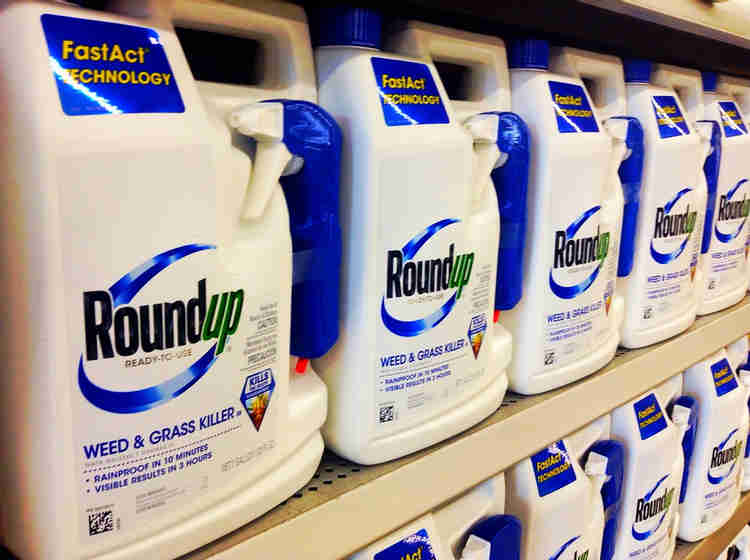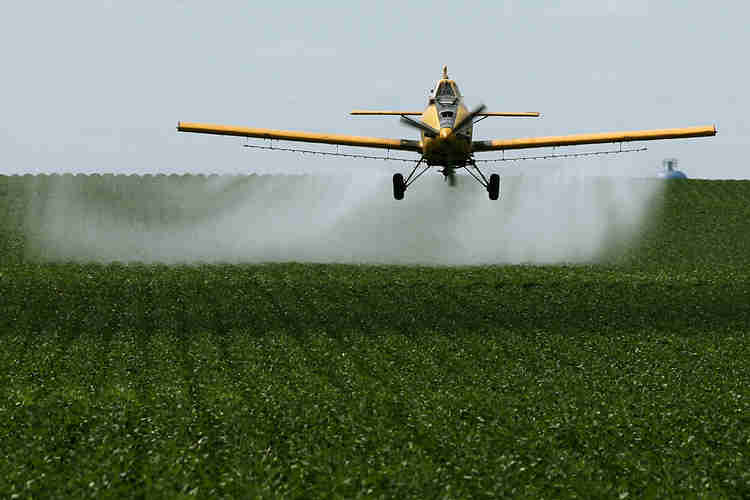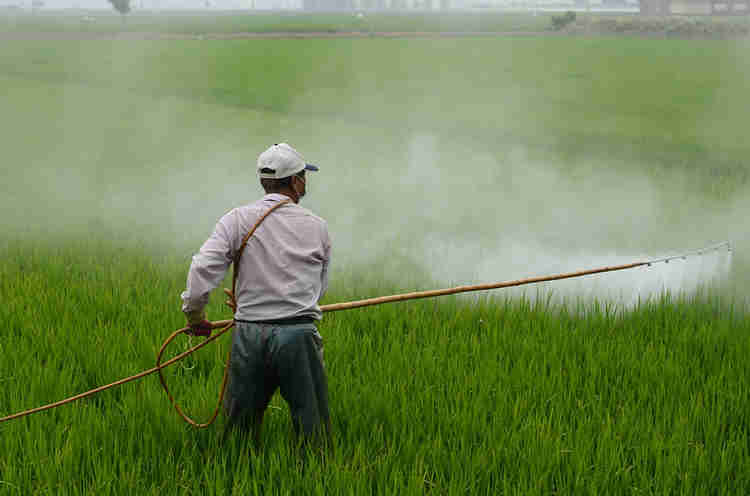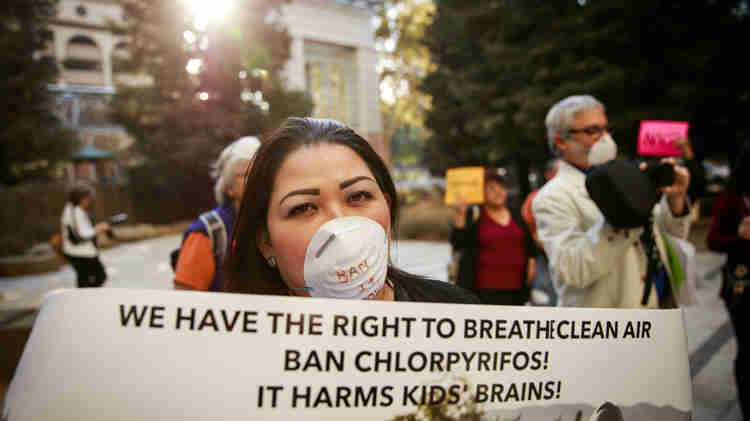Pesticides Are Everywhere
When we humans are bothered by other life forms, like insects, rodents, and weeds, we usually don’t think twice about using pesticides to get rid of them. From industrial agriculture to household products, pesticides are all around us. That’s why it’s important for us to know: how do pesticides affect the human body and our environment, particularly the air we breathe?
While pesticides may serve an important purpose in some cases, they can also have devastating consequences for the health of human beings and the natural world (which, of course, we depend on for our health). Let’s look at the role of pesticides in our food system, the health impacts of some of the most popular pesticides, and the groups of people who’re most susceptible to exposure.
Why Do We Use Pesticides?
For thousands of years, pest infestations have plagued farmers’ livelihoods. In the early twentieth century, advances in chemistry and biology led to the development of synthetic pesticides, which were more selective towards their target pests. Crop yields increased, especially as technology developed further for plant fertilization and irrigation, and eventually, GMOs.

Pesticides are primarily used in agriculture, but that doesn’t mean we don’t see the consequences of using them elsewhere. In fact, once pesticides were introduced at scale, it didn’t take long for them to make their way into the larger ecosystem. In the late fifties, people began to notice birds had stopped singing.
The phenomenon prompted Rachel Carson to write her groundbreaking book, Silent Spring (1962), where she uncovered how a pesticide called DDT was harming the environment, including birds’ reproductive systems. Millions read it, and the pesticide industry was faced with public outcry.
Thankfully, Silent Spring ushered in a new wave of regulations on some of the most harmful chemicals. But still, to this day, traces of dangerous pesticides remain in our environment due to their chemical persistence and the prior lack of regulation. Plus, many toxic pesticides are still heavily used in US agriculture, and the use of DDT is still approved in developing countries for its effectiveness in killing mosquitoes and fighting against the spread of malaria.
American taxpayer dollars heavily subsidize the industrial agricultural system, which uses pesticides (among other methods) to continue its large-scale, monoculture operations. Every year in the US, we apply about one billion pounds of pesticides. We’re the second-highest in the world, surpassed only by China.
Are the Most-Used Pesticides and Herbicides Safe?
While some active ingredients can have low toxicity, most chemicals in pesticides are typically used in formulations — i.e. in combination with other chemicals — which can change their makeup and make them more hazardous than they would be by themselves.

For example, RoundUp contains glyphosate as its active ingredient. On its own, glyphosate mostly targets plant cells, but RoundUp’s formulation has been heavily criticized for its potential carcinogenic effects on humans. This is likely due to the other components in RoundUp that increase cell permeability, which leads to these harmful effects.
Another pesticide called EnlistDuo combines glyphosate and 2,4-D to create another toxic formulation. It was created because the excessive use of RoundUp created RoundUp-resistant crops. By itself, 2,4-D has been associated with Parkinson’s disease, non-Hodgkin’s lymphoma, and reproductive problems. The US Environmental Protection Agency pledged to reconsider the use of EnlistDuo in 2015 after contentious legal battles, but it was reinstated in 2017, with expanded use.
To learn more about safety concerns of other pesticides, check out the EPA Pesticide Lookup.
How Pesticides Contaminate Our Air and Environment
Main Sources of Pollution

Most pesticides are used for agriculture. Have you ever seen those small yellow planes (called “crop dusters”) flying over the fields, spraying chemicals? Pesticides can also be sprayed closer to the ground, but there is still the risk that even then, the chemical can easily miss its intended target. That phenomenon is called pesticide drift.
Pesticide drift is a serious air quality concern. In California, pesticide concentrations in the air frequently exceed the EPA’s levels of acceptable exposure. Air monitoring studies have shown unsafe concentrations of several pesticides, and the regulatory standard fails to account for exposure to more than one pesticide at a time.
It’s not just rural agricultural communities who suffer from pesticide drift and exposure to unhealthy air quality. In urban areas, people can make mistakes when applying pesticides in their gardens, which can cause acute illnesses. Apartment residents in low-income areas can be subject to frequent fumigations, and when toxins remain indoors, they take a significantly longer time to degrade and diffuse. Household dust can even still contain trace remnants of DDT, despite its ban in 1972.
Environmental & Human Health Consequences
In California’s Central Valley, pesticides contribute directly to unhealthy air quality. At ground level, certain pesticides can form ozone, the primary ingredient in smog. Ozone pollution is likely to be a larger concern as climate change progresses. Rising temperatures lead to higher ozone levels and worsening air quality. In the Central Valley, pesticide drift further pollutes the air and causes residents respiratory issues.
In addition to affecting the quality of our air, pesticides can cause damage to the entire ecosystem. Certain chemicals can leach into groundwater or contaminate surface water systems.

Atrazine, another popular ingredient in herbicides, activates by dissolving in water. It acts as an endocrine disruptor, throwing our bodies’ hormones out of whack and hurting our reproductive systems. Atrazine is a chemically persistent compound and is frequently detected in drinking water throughout the Midwest.
Once released into the environment, pesticides easily bioaccumulate, meaning they build up in the tissues and cells of living creatures, especially those that were not targeted to begin with. When a bird eats several sprayed insects, and cannot excrete the toxin, the next predator who eats the bird is poisoned worse, at a higher pesticide concentration.
The phenomenon Rachel Carson reported in Silent Spring was partly caused by birds of prey suffering from this extreme level of poisoning. The effect can be astoundingly widespread in the food chain and the ecosystem. Traces of pesticides have even been found in polar bears living in the Arctic Ocean!
Negative Impacts of Pesticides on Human Health
An estimated 200,000 people die each year due to toxic pesticide exposure. Since pesticide drift can be invisible and odorless, determining what chemical you’ve been exposed to, and how, is often difficult. Basically, there are three physical ways you can be exposed to pesticides: 1) you breathe it in; 2) you touch it; or 3) you ingest it.
Your reaction will vary based on the way you were exposed, which can depend on what you do for a living, where you live, and what foods you eat. For example, someone whose job it is to apply pesticides to crops will have a much higher risk of exposure than the average person. These factors — route, dosage, and duration of exposure — all contribute to the severity of negative health effects.

As one might expect, farmworkers are on the front lines of exposure. According to the US Department of Labor, most farmworkers reside close to their work, further exposing them and their families to unhealthy air and potentially unsafe drinking water. This, combined with farmworkers’ low socioeconomic status, can exacerbate any health conditions they have or develop.
Vulnerable populations throughout the United States face a grave environmental injustice that is pervasive throughout our entire food system. Our current practices exploit and harm laborers, and expose all of us to chronic, low dosages of toxic chemicals. Whether it is through residues in our food, water, or air, pesticides pose a very serious risk to public health and safety.
What a specific pesticide will do to your body is largely determined by its individual properties and function. A pesticide like organophosphates that target an insect’s nervous system will likely cause neurological damage to humans. Glyphosate, on the other hand, targets a protein process in cells and is more heavily associated with carcinogenic effects.
Broadly speaking, here are some symptoms showing you may have been exposed to pesticides:
Short-Term
- Irritation of the nose, throat, and skin
- Rashes and blisters
- Nausea
- Dizziness
- Diarrhea
- Cold or flu-like symptoms
Long-Term
- Cancer and other tumors
- Brain and nervous system damage
- Birth defects
- Infertility and other reproductive problems
- Damage to the liver, kidneys, lungs, and other body organs
For information on the health effects of a specific pesticide, check the EPA Pesticide Lookup. If you believe you have suffered pesticide poisoning, call The National Pesticide Information Center at 800-858-7378 (toll-free). You can also learn more about worker protection rights (which, needless to say, could stand to be greatly expanded and better-enforced).
Pesticides’ Impact on Children’s Health

Pregnant women and children are highly vulnerable to toxins. There is a reason pregnant women are warned against drinking alcohol, eating certain foods, and taking certain medications. A developing fetus is extremely sensitive to chemicals of any kind, and birth defects can have lifelong effects.
Children born near agricultural areas that use pesticides have been found to have issues with brain development and a higher probability of developing autism spectrum disorder.Studies have also shown that, due to the pervasiveness of pesticides in our environment, every child in the Northern hemisphere will be exposed to pesticides from the moment of conception, and will likely experience the effects long-term.
Since kids’ bodies are growing at a high rate, they consume more food, water, and air relative to their body weight. A crawling toddler or a curious kid will also interact more with their environment, and many of their biological processes for dealing with toxins have not developed yet. Pesticide exposure at schools has caused acute illnesses in children. These include respiratory problems, gastrointestinal distress (vomiting, nausea, etc), headaches, dizziness, eye, and skin irritation.
Children are also susceptible to developing chronic conditions from environmental stressors. Asthma and other respiratory diseases have been associated with organophosphate pesticides like chlorpyrifos. Chlorpyrifos exposure has also been linked to lower IQs and delayed neurological development.
A Step Forward and Many More to Take
We have made significant strides in pesticide regulation. However, we are still reckoning with several persistent pesticides, and our continued use of these dangerous chemicals. Whether we can protect our health largely depends on decisions made by our regulatory agencies, who are required to balance health risks and economic costs. Advocates for clean air have championed many legal battles to ensure public health is the primary concern in these decisions.

In California, policies such as restricting pesticide use near schools and banning chlorpyrifos are a step in the right direction. But, unfortunately, not enough is happening at the federal level.
The United States is one of the largest consumers of pesticides, second only to China. Yet, our regulations have considerably weakened in recent years. Under the Trump administration, the EPA has been acting against their own research, allowing the continued use of over 100 pesticides it had originally pledged to phase out.
Certain chemicals like EnlistDuo also regained their registration, despite a court decision in 2014 to reconsider approval due to serious health concerns. Chlorpyrifos was also slated to be banned by the EPA because of the impacts on children, but the agency reversed course. These policies directly endanger people to adverse health effects and can lead to persistent ecological problems.
In order to protect our health in the near-term — and safeguard the future of humanity on our one spaceship, Earth — we must advocate for better agricultural practices and policies that prioritize the safety of our children, farmworkers, and us all. To learn more about action steps you can take in your community, check out Pesticide Action Network and Californians for Pesticide Reform.